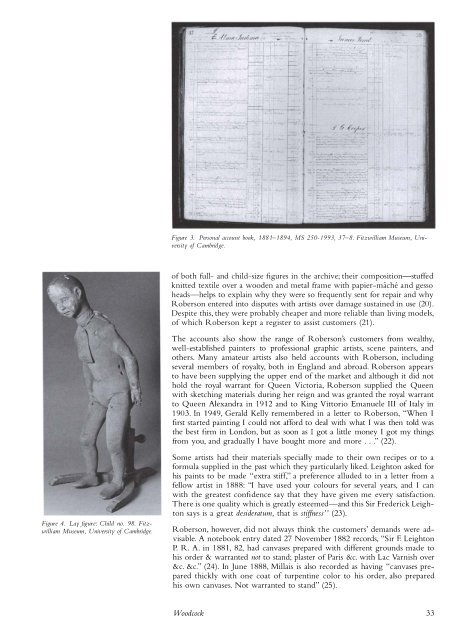Historical Painting Techniques, Materials, and Studio Practice
Create successful ePaper yourself
Turn your PDF publications into a flip-book with our unique Google optimized e-Paper software.
Figure 3. Personal account book, 1881-1894, MS 250- 1993, 37-8. Fitzwilliam Museum, University<br />
of Cambridge.<br />
of both full- <strong>and</strong> child-size figures in the archive; their composition-stuffed<br />
knitted textile over a wooden <strong>and</strong> metal frame with papier-mache <strong>and</strong> gesso<br />
heads-helps to explain why they were so frequently sent fo r repair <strong>and</strong> why<br />
Roberson entered into disputes with artists over damage sustained in use (20) .<br />
Despite this, they were probably cheaper <strong>and</strong> more reliable than living models,<br />
of which Roberson kept a register to assist customers (21).<br />
The accounts also show the range of Roberson's customers from wealthy,<br />
well-established painters to professional graphic artists, scene painters, <strong>and</strong><br />
others. Many amateur artists also held accounts with Roberson, including<br />
several members of royalty, both in Engl<strong>and</strong> <strong>and</strong> abroad. Roberson appears<br />
to have been supplying the upper end of the market <strong>and</strong> although it did not<br />
hold the royal warrant fo r Queen Victoria, Roberson supplied the Queen<br />
with sketching materials during her reign <strong>and</strong> was granted the royal warrant<br />
to Queen Alex<strong>and</strong>ra in 1912 <strong>and</strong> to King Vittorio Emanuele III of Italy in<br />
1903. In 1949, Gerald Kelly remembered in a letter to Roberson, "When I<br />
first started painting I could not afford to deal with what I was then told was<br />
the best firm in London, but as soon as I got a little money I got my things<br />
from you, <strong>and</strong> gradually I have bought more <strong>and</strong> more ..." (22).<br />
Figure 4. Lay figure: Child no. 98. Fitzwilliam<br />
Museum, University of Cambridge.<br />
Some artists had their materials specially made to their own recipes or to a<br />
formula supplied in the past which they particularly liked. Leighton asked for<br />
his paints to be made "extra stiff," a preference alluded to in a letter from a<br />
fellow artist in 1888: "I have used your colours fo r several years, <strong>and</strong> I can<br />
with the greatest confidence say that they have given me every satisfaction.<br />
There is one quality which is greatly esteemed-<strong>and</strong> this Sir Frederick Leighton<br />
says is a great desideratum, that is stiffness" (23).<br />
Roberson, however, did not always think the customers' dem<strong>and</strong>s were advisable.<br />
A notebook entry dated 27 November 1882 records, "Sir F. Leighton<br />
P. R. A. in 1881, 82, had canvases prepared with different grounds made to<br />
his order & warranted not to st<strong>and</strong>; plaster of Paris &c. with Lac Varnish over<br />
&c. &c." (24). In June 1888, Millais is also recorded as having "canvases prepared<br />
thickly with one coat of turpentine color to his order, also prepared<br />
his own canvases. Not warranted to st<strong>and</strong>" (25).<br />
Woodcock 33


